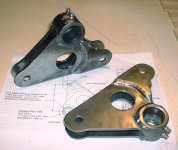skywagon8a
MEMBER
SE Mass MA6
That amount of differential is good for counteracting the adverse yaw. The secondary stops are at the control stick. My Cub doesn't have any at the surfaces. Don't worry about having too much as that will be controlled by pilot input. It is too little travel which would concern me. When rigging controls with stops at both ends of the system the surface stops are limiting with a small gap at the stick stops to ensure that the surface will move to it's limits.
I used a film camera for my pictures. Remember those? And pages of lined paper with a date, brief description of task and time spent. Put it all together in a loose leaf binder along with any sketches. DAR said that I didn't need all of that. Your DAR may have a different point of view, ask him.
I used a film camera for my pictures. Remember those? And pages of lined paper with a date, brief description of task and time spent. Put it all together in a loose leaf binder along with any sketches. DAR said that I didn't need all of that. Your DAR may have a different point of view, ask him.
Last edited:








